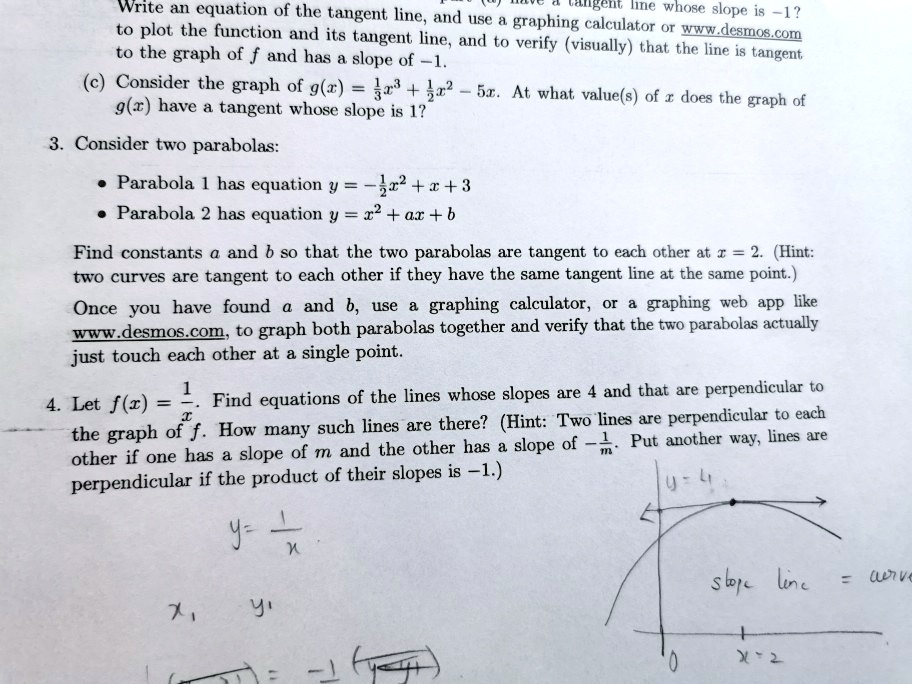Write an equation of the tangent line, use a graphing calculator to plot the function and its tangent line, or visit www.desmos.com to graph f and verify visually that the line is tangent. Consider the graph of g(w) = 3w^2 + 5. At what value(s) of w does the tangent line have a slope of 12? Consider two parabolas: Parabola 1 has equation y = -x^2 + 1 + 3. Parabola 2 has equation y = 2x^2 + ax + b. Find constants a and b so that the two parabolas are tangent to each other at x = 2. (Hint: two curves are tangent to each other if they have the same tangent line at the same point.) Once you have found a and b, use a graphing calculator or a graphing web app like www.desmos.com to graph both parabolas together and verify that the two parabolas actually just touch each other at a single point. Find equations of the lines whose slopes are 4 and that are perpendicular to the graph of f(x). How many such lines are there? (Hint: Two lines are perpendicular if one has a slope of m and the other has a slope of -1/m.)

The Correct Answer and Explanation is:
Here is the solution for question 3 on the provided sheet.
Answer: The constants are a = -5 and b = 9.
To determine the values of constants a and b that make the two parabolas tangent at x = 2, we must satisfy two essential conditions. The hint provided explains that for two curves to be tangent, they must share the same tangent line at that point. This implies that at x = 2, both the y-values of the parabolas must be equal, and the slopes of their tangent lines must also be equal.
Let’s define the two functions:
Parabola 1: f(x) = -½x² + x + 3
Parabola 2: g(x) = x² + ax + b
First, we set their y-values equal at x = 2, meaning f(2) = g(2). We can find the exact coordinate by plugging x = 2 into the equation for Parabola 1:
f(2) = -½(2)² + (2) + 3 = -½(4) + 5 = -2 + 5 = 3
So, the point of tangency is (2, 3). Now we know that g(2) must also equal 3.
g(2) = (2)² + a(2) + b = 4 + 2a + b
Setting this equal to 3 gives our first equation: 4 + 2a + b = 3, which simplifies to 2a + b = -1.
Second, we set their slopes equal at x = 2. The slope of a curve at a point is given by its derivative. We find the derivatives of both functions:
f'(x) = -x + 1
g'(x) = 2x + a
Now, we evaluate these derivatives at x = 2 and set them equal: f'(2) = g'(2).
f'(2) = -(2) + 1 = -1
g'(2) = 2(2) + a = 4 + a
Setting them equal gives: -1 = 4 + a. Solving for a, we find a = -5.
Finally, we substitute the value of a back into our first equation (2a + b = -1) to find b.
2(-5) + b = -1
-10 + b = -1
Solving for b, we get b = 9. equal. Second, they must have the same slope, meaning their derivatives are equal.
The two parabolas are:
Parabola 1: y = -1/2 * x^2 + x + 3
Parabola 2: y = x^2 + ax + b
Step 1: Equal y-values at x = 2
We start by setting the y-values of both equations equal to each other at x = 2.
For Parabola 1, y = -1/2 * (2)^2 + (2) + 3 = -2 + 2 + 3 = 3.
For Parabola 2, y = (2)^2 + a(2) + b = 4 + 2a + b.
Setting them equal gives our first equation:
3 = 4 + 2a + b
2a + b = -1
Step 2: Equal slopes at x = 2
Next, we find the derivative of each function to determine its slope. The derivative of a function gives the slope of the tangent line at any point x.
For Parabola 1, the derivative is y’ = -x + 1.
For Parabola 2, the derivative is y’ = 2x + a.
Now, we evaluate these derivatives at x = 2 to find the slope of each parabola at that point.
Slope of Parabola 1 at x = 2 is y’ = -(2) + 1 = -1.
Slope of Parabola 2 at x = 2 is y’ = 2(2) + a = 4 + a.
For the parabolas to be tangent, their slopes must be equal:
-1 = 4 + a
Solving for a gives:
a = -5
Step 3: Find b
With the value of a, we can now use our first equation (2a + b = -1) to find b.
2(-5) + b = -1
-10 + b = -1
b = 9
Thus, the constants are a = -5 and b = 9. The equation for the second parabola is y = x^2 – 5x + 9. If we were to graph y = -1/2 * x^2 + x + 3 and y = x^2 – 5x + 9, we would see them touch perfectly at the point (2, 3), confirming they are tangent.thumb_upthumb_down
